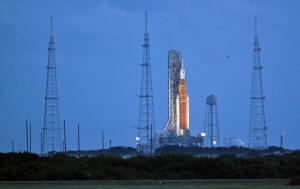Fuel leak to delay first launch of NASA's Artemis moon rocket for weeks
 Send a link to a friend
Send a link to a friend
 [September 06, 2022]
By Joey Roulette and Steve Gorman [September 06, 2022]
By Joey Roulette and Steve Gorman
CAPE CANAVERAL, Fla. (Reuters) -For the
second time in a week, NASA on Saturday aborted an attempt to launch its
giant, next-generation rocketship, citing a stubborn fuel leak that the
space agency said could delay the debut mission of its moon-to-Mars
Artemis program by at least several weeks.
Preflight operations were called off for the day about three hours
before the 2:17 p.m. EDT (1817 GMT) liftoff time targeted for the
32-story-tall Space Launch System (SLS) rocket and its Orion capsule
from Cape Canaveral, Florida.
The uncrewed test flight, aimed at launching the capsule out to the moon
and back, was to have marked the inaugural voyage of both the SLS and
Orion a half century after the last lunar mission of Apollo, forerunner
of the Artemis program.
The countdown was scrubbed after Kennedy Space Center technicians made
three failed attempts to fix a "large" leak of supercooled liquid
hydrogen propellant being pumped into the rocket's core-stage fuel
tanks, agency officials said.
The initial launch try on Monday was likewise foiled by technical
problems, including a different leaky fuel line, a faulty temperature
sensor and cracks found in insulation foam.
Mission managers proceeded with a second launch attempt on Saturday once
the earlier issues had been resolved to their satisfaction. And NASA had
reserved another backup launch time, for either Monday or Tuesday, in
case a third try was needed.

But after a review of data from the latest difficulties, NASA concluded
the new hydrogen leak was too tricky and time-consuming to finish
troubleshooting and fix on the launch pad before the current launch
period allotted to the mission expires on Tuesday.
The delay means the earliest opportunity to try again would come during
the next launch period that runs Sept. 19-30, or during a subsequent
October window, an associate NASA administrator, Jim Free, told
reporters at a late-afternoon briefing.
He said the postponement also would involve rolling the spacecraft back
into its assembly building, under Cape Canaveral "range" rules limiting
how long a rocket may remain at its launch tower before undergoing a new
round of safety checks indoors.
Mike Sarafin, NASA's Artemis mission manager, said efforts to resolve
the latest technical snag would entail "several weeks of work."
NASA chief Bill Nelson said earlier in the day that a rollback would
postpone the next launch attempt at least until mid-October, in part to
avoid a scheduling conflict with the next International Space Station
crew due for launch early that month.
Launch-day delays and malfunctions are not uncommon in the space
business, especially for new rockets such as NASA's Space Launch System,
a complex vehicle with a set of pre-liftoff procedures that have yet to
be fully tested and rehearsed by engineers without a hitch.
On average, the odds of scrubbing a launch on any given day for any
reason, including foul weather, are about one-in-three.
[to top of second column]
|

NASA's next-generation moon rocket, the
Space Launch System (SLS) with the Orion crew capsule perched on
top, stands on launch complex 39B as it is prepared for launch for
the Artemis 1 mission at Cape Canaveral, Florida, U.S. September 3,
2022. REUTERS/Steve Nesius

"We're not going to launch until it's right, and that is standard
operating procedure, and will continue to be," Nelson said at the
briefing.
The last-minute setbacks on the launchpad came at the tail end of a
development program more than a decade in the making, with years of
delays and billions of dollars in cost overruns under NASA's
respective SLS and Orion contracts with Boeing Co and Lockheed
Martin Corp.
MOON TO MARS
Apart from its technical challenges, Artemis I signals a major
turning point for NASA's post-Apollo human spaceflight program,
after decades focused on low-Earth orbit with space shuttles and the
International Space Station.
Named for the goddess who was Apollo's twin sister in ancient Greek
mythology, Artemis aims to return astronauts to the moon's surface
as early as 2025, though many experts believe that time frame will
likely slip.
Twelve astronauts walked on the moon during six Apollo missions from
1969 to 1972, the only spaceflights yet to place humans on the lunar
surface. But Apollo, born of the U.S.-Soviet space race during the
Cold War, was less science-driven than Artemis.
The new moon program has enlisted commercial partners such as SpaceX
and the space agencies of Europe, Canada and Japan to eventually
establish a long-term lunar base of operations as a stepping stone
to even more ambitious human voyages to Mars.
Getting the SLS-Orion spacecraft launched is a key first step. Its
first voyage is intended to put the 5.75-million-pound vehicle
through its paces in a rigorous test flight pushing its design
limits and aiming to prove the spacecraft suitable to fly
astronauts.
If the mission succeeds, a crewed Artemis II flight around the moon
and back could come as early as 2024, to be followed within a few
more years with the program's first lunar landing of astronauts, one
of them a woman, with Artemis III.

Billed as the most powerful, complex rocket in the world, the SLS
represents the biggest new vertical launch system NASA has built
since the Saturn V of the Apollo era.
Although no humans will be aboard, Orion will carry a simulated crew
of three - one male and two female mannequins - fitted with sensors
to measure radiation levels and other stresses that real-life
astronauts would experience.
(Reporting by Joey Roulette in Cape Canaveral, Fla., and Steve
Gorman in Los Angeles; Editing by Lisa Shumaker, Frances Kerry,
Chizu Nomiyama and Jonathan Oatis)
[© 2022 Thomson Reuters. All rights
reserved.]
This material may not be published,
broadcast, rewritten or redistributed.
Thompson Reuters is solely responsible for this content. |